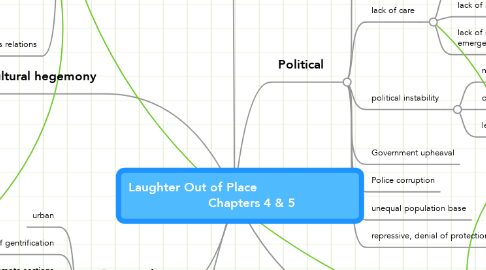
1. Cultural hegemony
1.1. Racial differences
1.1.1. white skin desirable
1.1.2. mulatto sexualized
1.2. Social structure
1.3. perpetuation of social norms regarding class structure
2. Economic
2.1. clear distinction between haves and have nots
2.1.1. visible disparity
2.1.2. inability to meet basic needs
2.2. previously agrarian move to cities
2.2.1. over populated cities
2.3. entering industry
3. Social Class Distinction
3.1. hierarchy of class culture clear
3.1.1. roles distinct and visible
3.1.1.1. writing
3.1.1.2. comportment
3.1.1.3. behavioral deference
3.1.2. neighborhood boundaries
3.2. social hierarchy based on whiteness
3.2.1. Mulata sexualized
3.2.2. black denigrated
3.2.3. white preferred
3.3. educational disparity
3.3.1. only cursory for poor
3.3.2. professional status expected for upper classes
3.3.3. survivalist vs. psychoanalysis
3.4. employment opportunities
3.4.1. poor work for upper classes
3.5. visible behavioral differences
3.5.1. deportment
3.5.2. writing
3.5.3. clothing
3.5.4. speech
3.6. geographic disparity
3.6.1. neighborhoods
3.6.2. schools
3.6.3. entrances & elevators
3.7. interclass relations
3.7.1. poor provide manual labor
3.7.2. provide care for upper classes
3.7.3. upper class provide payment and some handouts, detest manual labor
3.7.4. deference ingrained in class behavior
3.7.5. treatment based on color variations, whiteness
3.7.6. violence more prevalent for poor
4. Geography
4.1. urban
4.2. regions of gentrification
4.3. moved poorest out to remote sections
4.4. no infrastructure provisions for poor
4.5. transportation available but lengthy and costly 1/5th of daily wage
5. Political
5.1. police corruption
5.1.1. enact violence on the poor
5.1.2. extortion of poor
5.1.3. death squads
5.2. lack of care
5.2.1. infrastructure for poorer areas
5.2.2. lack of affordable health care
5.2.3. lack of safety, effective police, fore, emergency care
5.3. political instability
5.3.1. military states
5.3.2. dictatorships
5.3.3. leadership with vying left and right theory
5.4. Government upheaval
5.5. Police corruption
5.6. unequal population base
5.7. repressive, denial of protection
6. Survival
6.1. economic survival
6.1.1. kids contribute to family funds
6.1.2. gangs vs. honest work
6.2. family life
6.2.1. basic human needs
6.2.2. role of children nurturing vs. nurtured
6.3. safety
6.3.1. in a chaotic environment
6.3.1.1. tolerance of gang leadership
6.4. lack of knowledge or faith in social supports
6.4.1. knowledge
6.4.2. accessibility
6.5. learning to live in chaos and poverty
6.5.1. ability to laugh at absurdities
6.5.2. finding ways to fight the good fight
6.5.3. working with gang members to keep the peace
